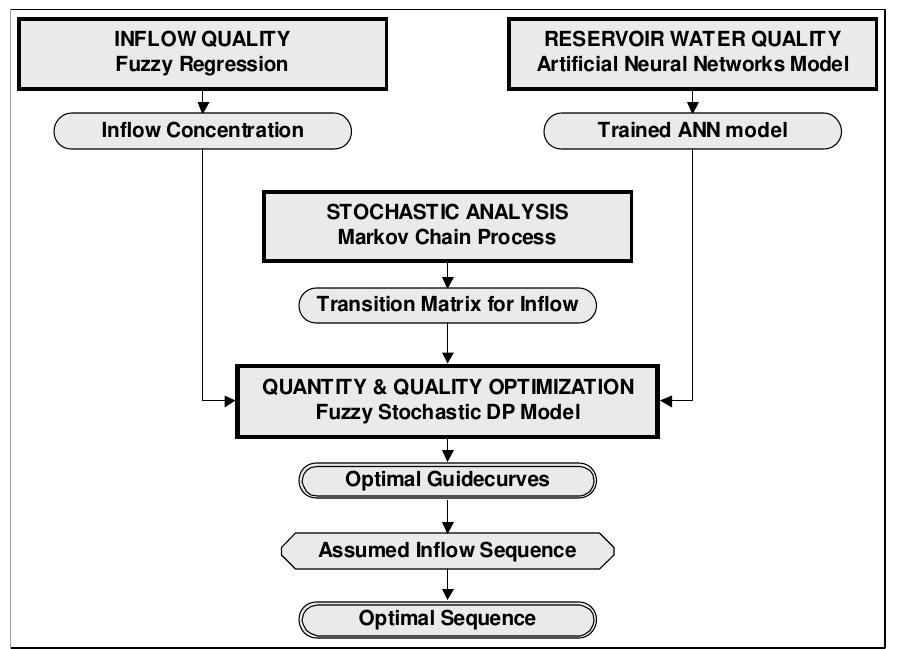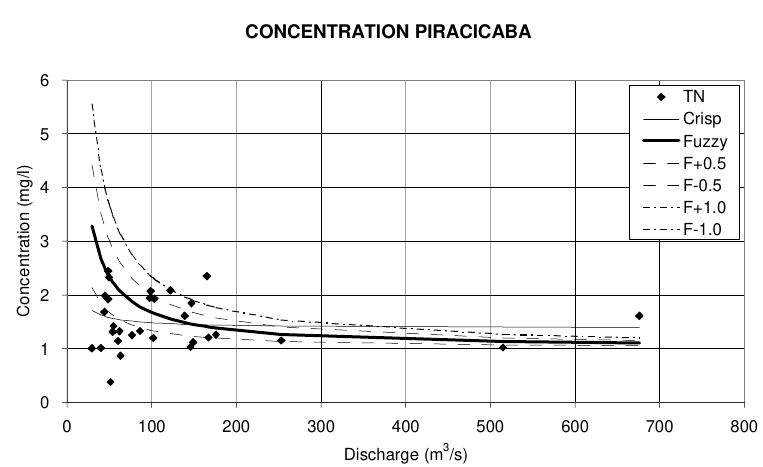Multi-objective storage reservoir operation under uncertainty
2003, 京都大学防災研究所年報. B= Disaster Prevention …
Abstract
Water quantity and quality are considered to be the main driving forces the reservoir operation. Barra Bonita reservoir, located in the southeast region of Brazil, is chosen as the case study for the application of the proposed methodology. Herein, optimization and artificial intelligence (AI) techniques are applied in the simulation and operation of the reservoir. A fuzzy stochastic dynamic programming model (FSDP) is developed for calculating the optimal operation procedures. Optimization is applied to achieve multiple fuzzy objectives. Markov chain technique is applied to handle the stochastic characteristics of river flow. Water quality analysis is carried out using an artificial neural network model. Organic matter and nutrient loads are modeled as a function of river discharge through the application of a fuzzy regression model based on fuzzy performance functions. The obtained results show that the proposed methodology provides an effective and useful tool for reservoir operation.
FAQs
AI
What novel methods are used for reservoir operation under uncertainty?
The study employs fuzzy set theory and dynamic programming to optimize multi-objective reservoir operations, improving management under uncertainty. Traditional techniques like goal programming are compared to fuzzy methods for greater flexibility in handling imprecise objectives.
How does water quality impact reservoir management decisions?
The paper highlights that water quality variables significantly affect decisions on water allocation for multiple uses, such as irrigation and recreation. Poor water quality can lead to eutrophication, posing further challenges in resource optimization.
What challenges are associated with water quality data in reservoir studies?
Limited and infrequent observational data restrict the ability to model complex water quality phenomena effectively, resulting in potential inaccuracies. For example, only 24 observations collected over several years were available for analyzing the Barra Bonita reservoir.
How does the application of artificial neural networks enhance water quality modeling?
The ANN model, preferred over physical models, simplifies the prediction of water quality by reducing computational demands associated with complex parameter estimation. It utilizes genetic algorithms for training, allowing for a more robust simulation despite limited data availability.
What are the implications of multi-objective optimization in reservoir operations?
Integrating multiple objectives, such as environmental quality and economic efficiency, complicates reservoir management but leads to more sustainable outcomes. The proposed fuzzy multi-objective fuzzy regression approach provides a structured means to evaluate conflicting objectives in real-time decision-making.
References (31)
- Bardossy, A, et al. (1990): Fuzzy Regression in Hydrology. Water Resource Research, 26 (7), pp. 1497-1508.
- Bellman, Richard (1959): Dynamic Programming, Princeton University Press. New Jersey. Bollmann and Marques (2000): Bases para a Estruturação de Indicadores de Qualidade de Águas. RBRH Vol 5 No.1 Jan/Mar, pp. 37-60. ABRH. Brazil.
- Chang, Y.H.O., B.M. Ayyub (2001): Fuzzy regression methods -a comparative assessment. Fuzzy Sets and Systems, 119, pp. 187-203.
- Changchit and Terrell (1989): CCGP model for multi-objective reservoir systems. Journal Water Resource Planning and Management, ASCE 115(5), pp. 658-670.
- Chaves, P. (2002): Planning Operation of Storage Reservoir for Water Quantity and Quality, Master Thesis, Graduate School of Engineering, Kyoto University, Japan.
- Diamond, P. (1988): Fuzzy least square. Information Science, 46, pp. 141-157.
- Dombi, J. (1990): Membership function as an evaluation. Fuzzy Sets and Systems, 35, pp. 1-21.
- Dubois, D. and Prade, H. (1980): Fuzzy Sets and Systems: Theory and Applications, pp. 393, Academic, California.
- El-Swaify and Yakowitz, editors (1998): Multiple Objective Decision Making for Land, Water, and Environment Management, Proceedings of the First International Conference on Multiple Objective Decision Support Systems (MODSS) for Land, Water and Environment Management. CRC Press LLC. Hawaii.
- Esogbue, Augustine O., et al. (1989): Dynamic Programming for Optimal Water Resources Systems Analysis. Prentice Hall Inc. USA.
- Fontane, D., et al. (1997): Planning Reservoir Operation with Imprecise Objectives, Journal of Water Resources Planning and Management, pp. 154-162, May/June.
- Galvao, C. O. and Valenca, M.S. editors (1999): Sistemas Inteligentes: Aplicacoes a Recursos Hidricos e Ciencias Ambientais, ABRH. Brazil.
- Hagan et al. (1995): Neural Network Design, PWS Publishing Company, Boston.
- Kacprzyk, Janusz (1997): Multistage Fuzzy Control, Wiley. England.
- Klir, G. and Yuan, B. (1995): Fuzzy sets and fuzzy logic: theory and applications, Prentice-Hall, Inc., Englewood Cliffs. USA.
- Kojiri, Toshiharu (1992): Planning of reservoir Construction through Fuzzy Optimization, DPRI, Japan.
- Labadie, J.W. (1993): Combining Simulation and Optimization in River Basin Management, Stochastic Hydrology and its Use in Water Resources Systems Simulation and Optimization, pp. 345-371. NATO ASI Series. Kluwer Academic Publishers. The Netherlands.
- Maier, H. and Dandy, G. (2000): Neural networks for the prediction and forecasting of water resources: a review of modeling issues and applications, Environment Modeling & Software, Vol. 15, pp. 101-124.
- Norwick, A. and Turksen, I. (1984): A model for the measurement of membership and consequences of its empirical implementation, Fuzzy Sets and Systems, 12(1), pp.1-25.
- Porto, Rubem, et al. (2000): Integration of Water Quantity and Quality in Strategic River Basin Planning, Journal of Water Resources Planning and Management, pp. 85-97, March/April. USA.
- Rea, L. and Parker, R. (1993): Designing and conducting survey research: a comprehensive guide, Jossey-Bass Pub., San Francisco, CA.
- Redden, D.T., Woodall, W.H. (1996): Further examination of fuzzy linear regression. Fuzzy Sets and Systems, 79, pp. 203-211.
- Russel, Samuel and Campbell, Paul (1996): Reservoir Operation Rules With Fuzzy Programming, Journal of Water Resources Planning and Management, pp. 165-170.
- Savic, D.A., Pedrycz, W. (1991): Evaluation of fuzzy linear regression models, Fuzzy Sets and Systems, 39, pp. 51-63.
- Shrestha, Bijaya (1996): Fuzzy Rule-Based Modeling of Reservoir Operation, Journal of Water Resources Planning and Management, pp. 262-269.
- Simonovic, S (1991): Coping with changing objectives in managing an existing multipurpose reservoir, Hydro. Of Natural and Manmade Lakes, Publ. No. 206, G. Schiller et al., eds., Int. Assn. of Hydro. Sci., Wallingford, UK, pp. 181-189.
- Torabi, M. and Mobasheri, F. (1973): A Stopchastic Dynamic Programming Model for the Optimum Operation of a Multi-purpose Reservoir, Water Resources Bulletin, American Water Resources Association, Vol. 9, No. 6.
- Tran, L., L. Duckstein (2002): Multi-objective fuzzy regression with central tendency and possibilistic properties, Fuzzy Sets and Systems, 130, pp. 21-31.
- Tundisi, J.G. and Tundisi, M. (1990): Limnology and eutrophication of Barra Bonita Reservoir, S. Paulo State, Southern Brazil. Arch. Hydrobiol. Beith. Ergebn. Limnology, pp. 661-676. Stuttgart.
- Yakowitz, Sidney (1982): Dynamic Programming Applications in Water Resource, Water Resources Research, Vol. 18, No. 4, pp. 673-696.
- Zalewski, M. et al. (1997): Ecohydrology: A New Paradigma for Sustainable Use of Aquatic Resources, UNESCO. Paris, France.
 Paulo Sergio Dias Chaves
Paulo Sergio Dias Chaves






























